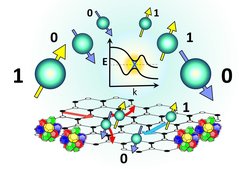Giant intrinsic spin Hall effect in W3Ta and other A15 superconductors
The Alexander von Humboldt Sofia Kovalevskaja group at the Max Plank Institute of Microstructure Physics, led by Dr. Mazhar Ali, published a new manuscript in Science Advances detailing a new way to find materials for next generation computers.
A leading candidate for future computing technologies is the field of “Spintronics”, which harnesses both an electron’s spin as well as its charge for information processing. Magnetic memory (MRAM), based on this field, has already become commercially available through companies like Everspin and IBM. Spintronic devices rely on the generation of large spin currents; ideally at low power and room temperature, and one popular method to create these is using the spin Hall effect: when a charge current is sent through a material like platinum or tungsten, a spin current is generated orthogonal to it. Researchers are still searching for cheaper materials with large spin Hall effects, but it is not easy; no simple material recipe exists. In the study by Derunova et al, the authors develop a set of guidelines for the discovery of new spin Hall materials based on patterns in their electronic structures. They suggest several promising new compounds and a methodology for large scale, high throughput screening of candidate materials, which may one day lead to the creation of better and cheaper spintronic devices.
Read the paper at: DOI: 10.1126/sciadv.aav8575

Abstract: The spin Hall effect (SHE) is the conversion of charge current to spin current, and nonmagnetic metals with large SHEs are extremely sought after for spintronic applications, but their rarity has stifled widespread use. Here, we predict and explain the large intrinsic SHE in β-W and the A15 family of superconductors: W3Ta, Ta3Sb, and Cr3Ir having spin Hall conductivities (SHCs) of −2250, −1400, and 1210












